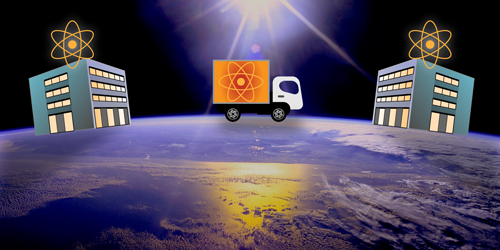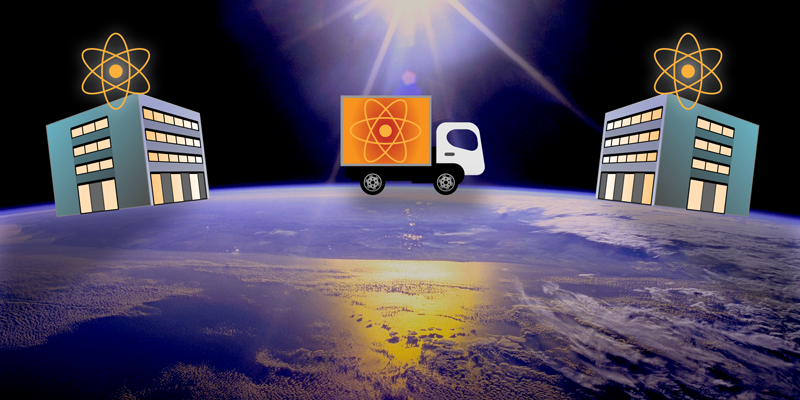Transportable Clocks Move with the Times
Anyone who wears a wristwatch can appreciate the convenience of knowing the time in different locations or of using it to check whether different clocks are synchronized. Similarly, people working with the highest-accuracy atomic clocks also need to access time and frequency information in remote locations, and they need to check that clocks in different laboratories around the world are running at the same rate. This is where atomic clocks that can be moved and operated in different locations find their niche. There will always be a compromise in accuracy and stability, however, when clocks travel beyond the controlled environment of a laboratory, and their size is shrunk to make them portable. But now, Christian Lisdat and co-workers at the National Measurement Institute in Germany [1] have built a transportable optical atomic clock that can achieve a fractional-frequency uncertainty of seven parts in —equivalent to losing or gaining no more than one second in 400 million years. Xueren Huang and co-workers at Wuhan Institute of Physics and Mathematics in China [2] have also developed a compact optical atomic clock that reaches a similar uncertainty, with a view to making it transportable as well. Now, for the first time, transportable clocks have gone beyond the one part in uncertainty level of the best microwave-frequency cesium clocks, which provide the current standard for the unit of time [3, 4]. They are also close to the performance of laboratory-based optical clocks, which can attain uncertainties of a few parts in [5, 6].
Atomic clocks “tick” with the oscillations of an electromagnetic wave whose frequency is locked to that of an atomic transition. The superiority of optical clocks over microwave cesium clocks is due to the much higher tick rate of optical waves compared with microwaves. Optical clocks can outperform cesium standards in both fractional-frequency stability and accuracy by up to 2 orders of magnitude [7]. This outperformance is fuelling the need to redefine the second in the International System of Units (SI) in terms of an optical frequency standard, moving away from the definition based on cesium. But before such a redefinition can take place, we must be confident in the reproducibility of optical clocks around the world by performing state-of-the-art comparisons between them.
Currently, for clocks that are on different continents, satellite-based methods have been the best option to compare the clock frequencies, but the measurement noise introduced by the satellite link limits the stability of the clock comparison. An optical-fiber link would be preferable, but this is not currently achievable on intercontinental scales. A transportable optical clock such as those now developed by Lisdat and colleagues and Huang and colleagues could travel between laboratory clocks located anywhere in the world and carry out a series of clock comparisons at a level surpassing both satellite-based methods and previously developed transportable clocks (Fig. 1). This would enable significant progress towards a redefinition of the SI second.
Transportable optical clocks can be used in many other ways too. An interesting application is in surveying the potential of Earth’s gravity field, since, in accordance with general relativity, time runs at different rates in different gravitational potentials [8, 9]. The magnitude of the effect enables clocks with fractional-frequency uncertainties of one part in to resolve changes in the gravity potential arising from a height difference of 10 cm relative to a reference clock in a fixed location. This makes clocks competitive with other surveying techniques to determine height differences between sites separated by hundreds of kilometers. In the future, we may see transportable clocks being used to align height reference systems in different countries, which matters when building international bridges or pipelines, for example. Clocks positioned in remote locations could also be used for long-term environmental monitoring by measuring height changes in ice sheets and ocean levels.
Designing optical clocks that are robust enough to operate in the field, as opposed to in the lab, is a significant challenge, particularly because they are generally very sensitive to vibrations and temperature fluctuations in the environment. Lisdat and colleagues have impressively demonstrated that their system is fully transportable by installing it in a car trailer, forming a mobile lab that has successfully operated in two measurement campaigns outside their institute. Their clock and the clock of Huang’s team were both designed in a compact and modular way to increase robustness against environmental disturbances, although the clocks are based on different atomic systems. Lisdat and co-workers’ clock uses a cloud of several thousand neutral strontium-87 atoms, whereas Huang and co-workers’ clock is based on just a single positively charged ion of calcium-40. Huang and colleagues’ clock has the advantage of simplicity in its laser systems, allowing it to be smaller and cheaper to build, fitting into a volume of just , excluding electronics. Lisdat and colleagues’ clock benefits from a larger number of atoms, which gives it a better signal-to-noise ratio each time the atomic transition frequency is probed. This enables the strontium-atom clock to average through statistical noise with fewer probe cycles, reaching a given statistical uncertainty 300 times faster than the single-ion clock. This speedup allows measurements to be taken in minutes rather than days, which is an important practical consideration for the end user of the clocks.
These transportable systems are now capable of making international clock comparisons in support of the effort to redefine the SI second in terms of an optical frequency. Lisdat and colleagues report that, in the near future, it looks feasible to achieve uncertainties below one part in in their clock with further characterization of the frequency shift induced by the laser light that traps the atoms. Such an improvement would yield a tool for surveying gravitational-potential and height differences with sub-10-cm accuracy. Work is also in progress to develop optical clocks for their first use in space [10], opening up possibilities for improved satellite navigation systems and tests of fundamental laws of physics such as the Einstein equivalence principle. As the clocks continue to be made more robust and compact, they will become accessible to a new, wider community of users, and only time will reveal the full range of applications for transportable optical clocks.
This research is published in Physical Review Letters and posted on the arXiv.
References
- S. B. Koller, J. Grotti, St. Vogt, A. Al-Masoudi, S. Dörscher, S. Häfner, U. Sterr, and Ch. Lisdat, “Transportable Optical Lattice Clock with Uncertainty,” Phys. Rev. Lett. 118, 073601 (2017).
- J. Cao, P. Zhang, J. Shang, K. Cui, J. Yuan, S. Chao, S. Wang, H. Shu, and X. Huang, “A Transportable Single-Ion Clock with Systematic Uncertainty,” arXiv:1607.03731.
- J. Guena et al., “Progress in Atomic Fountains at LNE-SYRTE,” IEEE Trans. Ultrason. Ferroelectr. Freq. Control 59, 391 (2012).
- T. P. Heavner, E. A. Donley, F. Levi, G. Costanzo, T. E. Parker, J. H. Shirley, N. Ashby, S. Barlow, and S. R. Jefferts, “First Accuracy Evaluation of NIST-F2,” Metrologia 51, 174 (2014).
- T. L. Nicholson et al., “Systematic Evaluation of an Atomic Clock at Total Uncertainty,” Nature Commun. 6, 6896 (2015).
- N. Huntemann, C. Sanner, B. Lipphardt, Chr. Tamm, and E. Peik, “Single-Ion Atomic Clock with Systematic Uncertainty,” Phys. Rev. Lett. 116, 063001 (2016).
- A. D. Ludlow, M. M. Boyd, J. Ye, E. Peik, and P. O. Schmidt, “Optical Atomic Clocks,” Rev. Mod. Phys. 87, 637 (2015).
- R. Bondarescu, A. Schärer, A. Lundgren, G. Hetényi, N. Houlié, P. Jetzer, and M. Bondarescu, “Ground-Based Optical Atomic Clocks as a Tool to Monitor Vertical Surface Motion,” Geophys. J. Int. 202, 1770 (2015).
- C. W. Chou, D. B. Hume, T. Rosenband, and D. J. Wineland, “Optical Clocks and Relativity,” Science 329, 1630 (2010).
- K. Bongs et al., “Development of a Strontium Optical Lattice Clock for the SOC Mission on the ISS,” C. R. Phys. 16, 553 (2015), Special Issue: The measurement of time/La mesure du temps, edited by C. Salomon.





